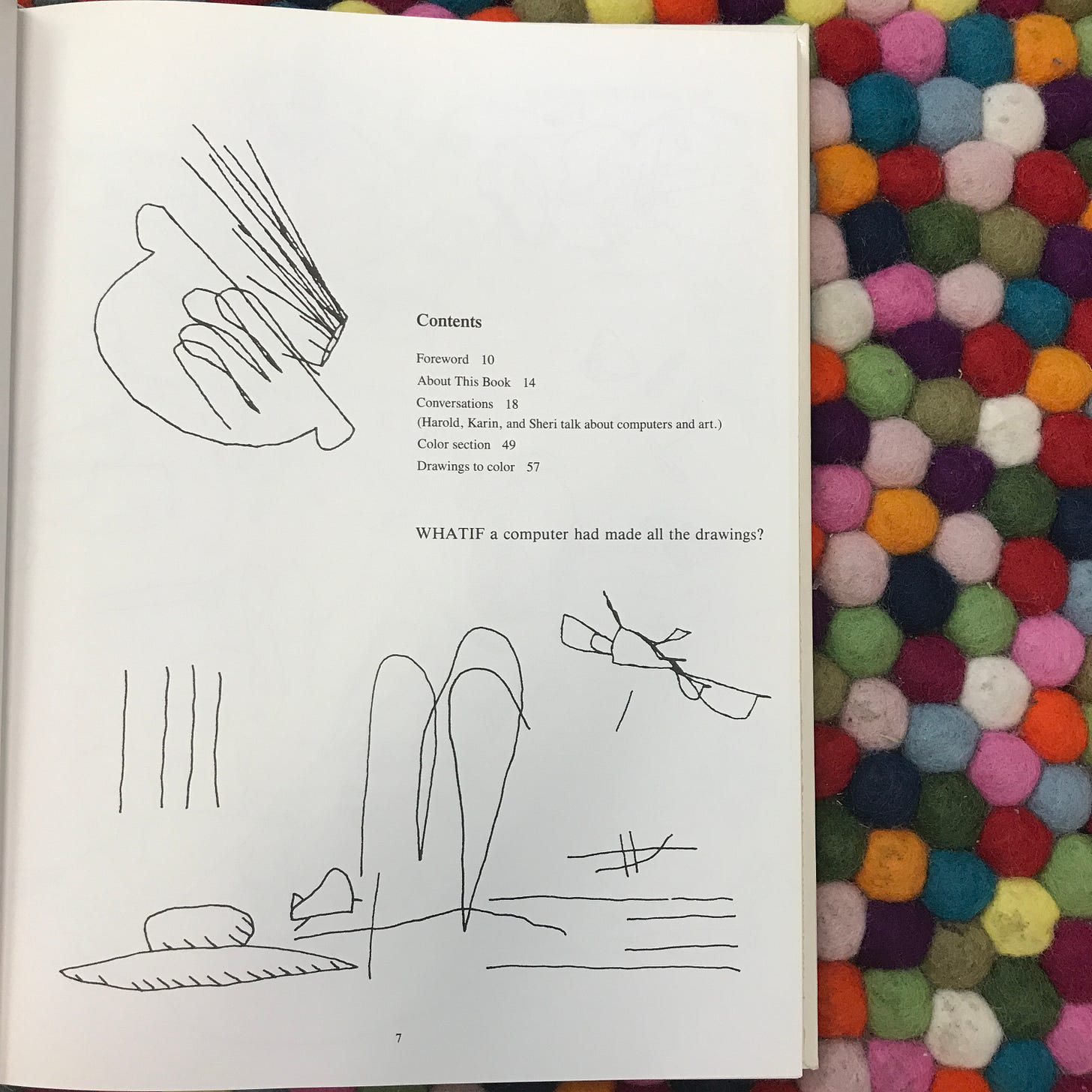No. 57 - The First Artificial Intelligence Coloring Book ⫶ Bayesian Forest ⫶ East Coast 24'
The model is a reminder.
My name is Linda. I write a bi-weekly newsletter about computer science, childhood, and culture - and there are 9655 of you listening. If you enjoy this issue, please share it with anyone who may find it helpful.
Cleaning up my attic, I found this Harold Cohen book I bought in 2017. The book is long out-of-print, so I had all kinds of alerts set up to find it. The First Artificial Intelligence Coloring Book is from 1984 and is still one of the most delightful and wise AI books ever written. A meeting of three kinds of intelligences: grownup, machine, and child. Harold, AARON, Becky, and Penny.
In Coloring Book, Cohen, a painter, writes computer programs to draw shapes. He would go on to work on AARON, the software, for almost 40 years..
The text is a dialogue between Cohen and the two children on ideas, coloring, creative process, and art in general. The shapes have an energy of their own. Like an exuberant toddler, AARON’s squiggles and lines fill the margins. And it’s a co-operation. While the shapes are drawn using a plotter, directed by AARON, the coloring is done by Cohen, the children, and eventually, the reader. Thirty-five computer-made line drawings are left to be colored.
V&A has a nice collection of Cohen’s work. I didn’t know he was of the same British era as David Hockney. Once, Cohen was asked, “Who is the artist—Cohen or AARON?” to which he compared the software to the relationship between Renaissance painters and their studio assistants. (Hockney famously worked on the Hockney-Falco thesis and camera obscura!) Cohen went on to have a long career in algorithmic and generative art.
There is something so joyous about the approach of the book. Even though the questions that drove Cohen’s work were complicated - what makes an image? what makes it evocative? how do artists process information in the creation of artworks? - his approach was to bring the topics to the domain of the ordinary.
Anyways, drawing is how you understand things in your head. And the representation in your head profoundly changes how you think. Much of generative AI art misses this point, or at least the training datasets are a bland representation of lived experiences, not an entire human life. And as John Berger says, all great drawing is drawing by memory.
”All great drawing is drawing by memory. That is why it takes so long to learn. If drawing were transcription, a kind of script writing, it could be taught in a few years. Even before a model, you draw from memory. The model is a reminder. Not of a stereotype that you know by heart. Not even of anything you can consciously remember. The model is a reminder of experiences you can only formulate and therefore only remember by drawing.”
— John Berger, A Painter of Our Time: A Novel
Linked List
In computer science, a linked list is a linear collection of data elements whose order is not given by their physical placement in memory. But here it is a selection of things I’ve been reading lately.
The Vesuvius Challenge has been making the rounds, but I missed the newsletter. Anyways, I love the goal to resurrect an ancient library from the ashes of a volcano with the power of computers - I imagine for a ten-year-old me who loved antiquity, this would have made me pick CS as a career path.
Toxicode (again, the French!) made a lovely little game to teach Bayesian statistics and random forests. I can’t help but think it would be enjoyable to do an offline edition of this: like a treasure hunt where each randomly placed mushroom either give a positive or negative value. There would be a chart to update with each discovery.
At LACMA, they had an exhibition on early computer art called Coded: Art Enters the Computer Age, 1952–1982, that had just ended. Browsing through a selection of the pieces (Paolozzi and Bauhaus included!) was interesting. There is also a Spotify playlist.
Classroom
I’m hoping to surface and share stories from all of you and I’d love to see your creations! Here are a few teachers using Ruby in creative, fun and inspiring ways.
This time an ask:
I’m planning a work trip back to Winchester & Virginia for late spring 24’. Especially when traveling long-distance, it would be great to combine a few different engagements for one flight.
If schools/educational districts/other clients along East Coast US would be interested in organising some lectures/workshops/events - be in touch! Excited to be back.




